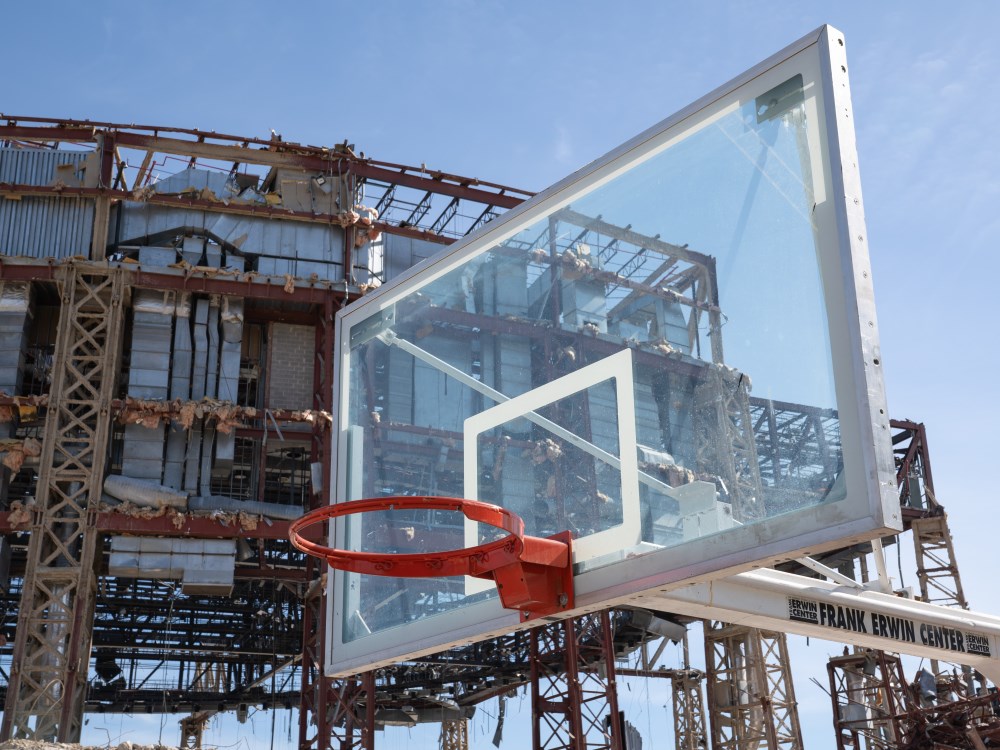
The Frank Erwin Center is coming down to make way for a new UT Austin-MD Anderson Cancer Center joint medical campus, but even in its demise, the former home of Longhorn basketball and many memorable moments in Austin's musical history is serving an important purpose.
The facility will act as a blueprint for reusing building materials beyond the core ingredients like concrete and steel. An innovative partnership between Texas Engineers, The University of Texas at Austin's Office of Sustainability and the construction team on the $25 million Erwin Center demolition project has led to the mapping and cataloging of reusable materials in the building, such as doors, chairs, tile, carpet, electronics and more.
This partnership will result in a set of policy recommendations that the University will apply to future capital projects, creating a more sustainable construction process. It will allow future project teams to improve methods for salvaging materials.
"There are so many useful materials in a big facility like the Erwin Center that can have a second life somewhere else," said Christopher Rausch, an assistant professor in the Fariborz Maseeh Department of Civil, Architectural and Environmental Engineering who is leading the reuse effort. "But because of the time and effort it takes, many of them just go to waste, and we want to keep that from happening."

Though many raw materials will be recycled, including roughly 3,800 tons of steel and 20,000 tons of concrete, making up roughly 80% of the building, the goal is to take this sustainable process even further by cataloging more complex materials that could be reused in other facilities.
Rausch and his team used Light Detection and Ranging (LiDAR) technology to map the building. This is the same sensing technology that guides autonomous vehicles and helps government agencies map our changing landscape.
The team used the images to catalog visible materials and "peel back the onion" of the building and examine materials behind walls or above ceilings. They then ranked those materials by their reuse potential, sorting them into four categories: A (strong marketplace for reuse), B (contingent on finding a buyer), C (requires additional condition testing), and D (not practical for reuse, but can be recycled). Items like lock systems, motors, controllers, transformers, chairs, fire alarm panels, security systems were scored among the most reusable items.
"Categorizing these materials helps the University know next time where to focus salvage efforts early on to save some of these things that could be reused somewhere else," Rausch said.

Rausch joined the Cockrell School in 2022 after several years in the construction industry. He focuses on improving the construction process through automation, design innovation and sustainability improvements.
Soon after coming to UT, he began working with the Office of Sustainability. He sought to bring his innovative techniques to capital projects on campus. The office plugged Rausch into the Erwin Center demolition, even though it was already underway.
"It’s more about the opportunity for future buildings, to divert even more materials than we did with the Erwin Center, to save and reuse every scrap we can and keep it from getting buried," said Jim Walker, director of the Office of Sustainability.
UT’s Green Fund supported Rausch's work on the Erwin Center. His work is an example of the projects the Green Fund supports: those that use the Forty Acres as a “living lab,” where students, faculty and staff can apply their research to real-life projects.
In addition to a more sustainable construction process, organizations like school districts, nonprofits and other universities could benefit from a robust reuse process. Plenty of services will help find new homes for doors, kitchen equipment and electronics. But all that takes time.
"If you have better information earlier, and that's what Chris' research is all about, you're more able to make those connections and set up those logistics to divert materials," Walker said.
Demolition on the Erwin Center began last fall. The arena, which can still be seen from Interstate 35 through Austin, is now roofless, and most of the walls are gone, too. After the building comes down in late May, crews will spend the summer clearing the site.
The demolition was done conventionally using construction equipment rather than explosives for safety purposes and to limit impact on surrounding areas and buildings.
Groundbreaking on the new medical center is expected in 2026. The University of Texas at Austin Medical Center will start with two new hospital towers – The University of Texas MD Anderson Cancer Center and a UT Austin hospital.







